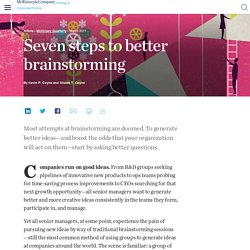

Eight Tips for Better Brainstorming. A recent Wall Street Journal story took on the hot topic of brainstorming.

Titled "Brainstorming Works Best if People Scramble For Ideas on Their Own," the piece quoted research showing that people are "more creative" when they "brainstorm" alone rather than in meetings and offered supporting testimonials from managers. This is a subject I am quite familiar with. Along with Andy Hargadon, I completed an 18-month ethnography in the 1990s on how the innovation consultants at IDEO do creative work, and we've both spent much of the past decade studying other innovative organizations. At the time, Andy was my PhD student, and now he is an associate professor at the University of California at Davis. We agree that badly managed face-to-face brainstorms do stifle creativity and we agree that, even when brainstorming is done right, people probably can still generate ideas faster when they work alone.
A common topic in these experiments is "What would happen if everyone had an extra thumb? " 7 Ways to Brainstorm Brilliant Ideas. Seven steps to better brainstorming. Most attempts at brainstorming are doomed.

To generate better ideas—and boost the odds that your organization will act on them—start by asking better questions. Companies run on good ideas. From R&D groups seeking pipelines of innovative new products to ops teams probing for time-saving process improvements to CEOs searching for that next growth opportunity—all senior managers want to generate better and more creative ideas consistently in the teams they form, participate in, and manage.
Yet all senior managers, at some point, experience the pain of pursuing new ideas by way of traditional brainstorming sessions—still the most common method of using groups to generate ideas at companies around the world. The scene is familiar: a group of people, often chosen largely for political reasons, begins by listening passively as a moderator (often an outsider who knows little about your business) urges you to “Get creative!” The result? It doesn’t have to be like this. 1. 2. 3. 4. 5. Six Surefire Ways to Kill a Brainstorm. Facebook may be the dominant player in social media, mobile advertising, and news, but Snapchat is the most formidable competitor it’s ever encountered.

Snapchat has a great feel for what its more than 100 million daily users want, and it moves fast. Combine that with its attractive demographics—86% of Snapchatters are between the ages of 13 and 34—and you can see why these two companies are now battling it out in one of the most passive-aggressive rivalries since the Cold War.
Neither company nor its leaders publicly say anything untoward; they just let their product updates speak volumes. Snapchat woos media companies with its roster of Discover channels; a few months later, Facebook woos them with Instant Articles. Facebook launches Sports Stadium to create a home for fans watching a big game; nine days later, Snapchat introduces live score and stat filters for pictures and videos from NBA games and other events. Seven Secrets to Good Brainstorming. When all the current cost cutting is over and business models begin to make sense again, Tom Kelley believes that one thing will differentiate winning companies from also-rans: their ability to innovate.

Allow Kelley his bias. Author of The Art of Innovation: Lessons in Creativity from Ideo, America's Leading Design Firm (Doubleday, 2001) and general manager of Ideo Product Development, one of the world's premiere product-development firms, Kelley has innovation coursing through his veins. But even discounting Kelley's evangelism, there's merit in his argument. According to The Economist's Innovation Survey, half of the U.S. economy's current growth comes from companies that didn't exist 10 years ago. Corporate titans have learned to fear the prodigy in his dorm room or the garage-based whiz kid who's forging a bullet with their company's name on it. But a poorly planned brainstorming session could cause more harm than good, Kelley points out. 1. 2.
Brainstorming Doesn't Work; Try This Technique Instead. Evan Rosenbaum was 2 years old when his father brought home the Power Macintosh 7100.

This was 1994, and the 7100, a new personal computer from Apple, was a hefty gray console, hardly anything to look at. To Get More Creative, Become Less Productive. There is a fundamental tension between productivity and creativity, and managers won’t get more of the latter until they recognize it. Productive people move through the tasks they have to accomplish in a systematic way. They make steady and measurable progress toward their goals. They make effective and efficient use of their time. Creativity… doesn’t. Creativity needs time and space to grow. That means people need to have the time to learn things that are not obviously relevant to their jobs, so that they will have a broad and deep knowledge base to draw from when they need to be creative. Moreover, creative enterprises rarely involve steady and measurable progress.
But these activities — building up a knowledge base and exploring it — take time. This difference between productivity and creativity is a central reason why many companies want more creativity from their employees than they get. The Truth about Breakthrough Strategies. Ford, Apple, Netflix, Starbucks, and Google struck gold with these breakthrough strategies, and changed the game in their respective industries: Offer a standard, mass-produced automobile Turn a personal computer into a “digital hub” for consumers Rent movies through a monthly, direct mail subscription service Create a “third place” between office and home to enjoy high-quality coffee drinks Organize the world’s information and make it universally accessible and useful Although each strategy is distinctive, they share a few common characteristics that tell us how breakthrough strategies really come to be.
